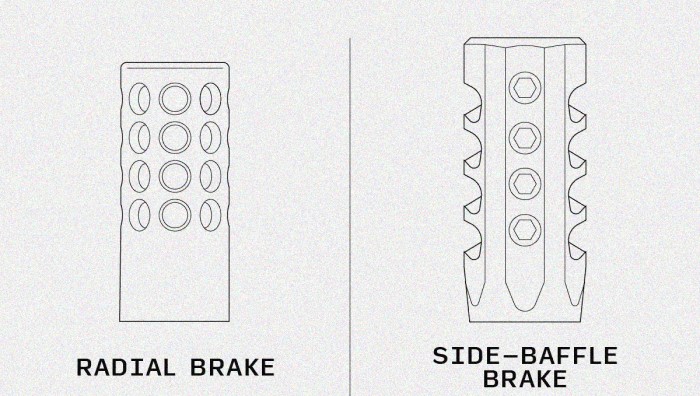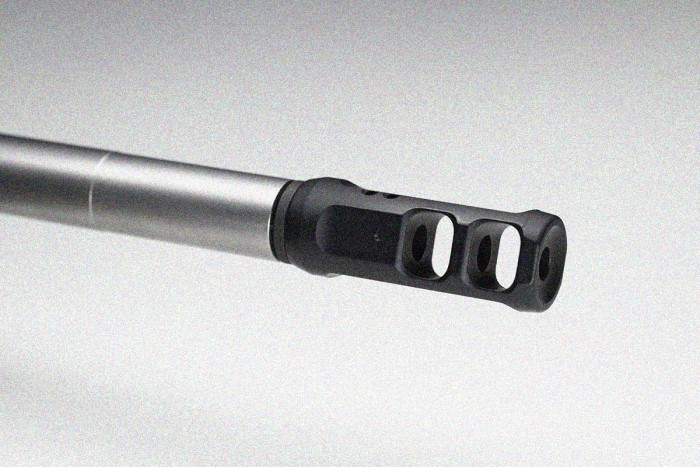A muzzle brake is a device attached to the muzzle of a firearm that redirects propellant gases to counter recoil and unwanted rising of the barrel during rapid fire. It “brakes” or stops the rearward movement of these gases, thereby counteracting (and usually as with many things related to firearms, there is some debate on whether or not muzzle brakes actually live up above their weight class in delivering what they promise).
Muzzle brakes are very effective at reducing recoil, as they allow the majority of the energy from the firing of a gunshot to be released in a rearward direction instead of overcoming the forward momentum of the bullet. This greatly reduces felt recoil, making it easier for the shooter to keep control of their weapon during rapid fire. Additionally, muzzle brakes can also help reduce muzzle rise, which can increase accuracy by keeping the barrel level during firing.
There are different types of muzzle brakes, with designs that vary depending on the intended purpose. Some common types are linear compensators, porting, and side-baffle brakes.
- Linear compensators redirect gases in a linear fashion away from the centerline of the bore so as counter rise (the tendency of the muzzle to rise during a rapid-fire).
- Porting involves drilling or machining holes into the top or sides of the muzzle brake which allows gases to exit in a rearward and slightly sideways direction.
- Side-baffle brakes feature internal baffles that guide gases out through ports in the sidewalls.
Whether or not muzzle brakes are worth the investment is a personal decision, but there is no doubt that they can be a helpful addition to any high-powered firearm. If you are looking for ways to improve your shooting experience, a muzzle brake may be something to consider.
Learn more in the video:
A muzzle brake is a mechanical device that is attached to the barrel of a firearm or cannon to redirect propellant gases and muzzle blast in order to counter recoil and unwanted muzzle rise.
There are a few different types of muzzle brakes available on the market, but most work by channeling the gases exiting the barrel through a series of passages or ports. These ports can be oriented in different ways to achieve different results, but they all work towards redirecting some of that gas away from the direction of rearward travel. Some muzzle brakes also feature escape ports near the muzzle end of the firearm which help to reduce noise and blast concussion.
Most muzzle brakes will offer recoil reduction, but it’s important to keep in mind that they are not a cure-all for recoil issues. Muzzle brakes can also increase noise levels, making them unsuitable for use in stealthy operations. Additionally, they create hazardous conditions for bystanders, as the redirected gases can be very hot and contain debris.
So, while muzzle brakes can be a useful tool for reducing recoil, they are not without drawbacks. It’s important to weigh the pros and cons before deciding if a muzzle brake is right for you.
There are a few ways to accomplish muzzle brakes, but generally, they work by diverting some of the concussion created when a bullet is fired forwards and to the sides, away from the shooter.
This is accomplished either through open ports or expansion chambers that redirect gasses exiting the muzzle.
The result is often drastically increased control over firearm recoil, particularly found on larger caliber weapons.
Additionally, muzzle brakes can be very effective at reducing reflections back towards the shooter from low light conditions or hiding spots, furthering their utility.
Some even have happy side benefits like concentrating more heat near the front sight (to counter historical problems with older night vision devices), which has given some name brands notoriety among competitive shooters.
Muzzle brakes work by redirecting expanding gases that exit the muzzle of a firearm. These gases are typically diverted to the sides and rearward, which creates a recoil-reducing effect. This can be beneficial for muzzle-heavy firearms that otherwise generate a lot of felt recoil. Additionally, muzzle brakes can help increase accuracy by reducing barrel rise during firing.
There are two main types of muzzle brakes:
- baffle type
- port type.
Baffle-type muzzle brakes have internal barriers that redirect gases, while port-type muzzle brakes have small holes that allow gas to escape in specific directions. Hybrid designs also exist, incorporating both baffles and ports.
A muzzle brake is a device that redirects exhaust gases from a firearm in order to counter recoil and unwanted rising of the barrel during firing. The reduction in recoil energy can result in less muzzle rise, allowing for quicker follow-up shots. Muzzle brakes are commonly used on increasingly powerful sniper rifles and long-range artillery guns.
Muzzle brakes work by redirecting the propellant gases that exit the muzzle after a round is fired. By doing this, the rearward force exerted on the firearm by these gases is reduced, leading to less felt recoil for the shooter. These devices usually have internal baffles or expansion chambers that serve to increase surface area and cause turbulence in the gas flow, both of which help to reduce recoil.
A muzzle brake is commonly used on high-powered firearms to reduce the recoil felt by the shooter.
The basic principle behind a muzzle brake is that it vents gases from the barrel to help counter recoil. This allows the gun to redirect some of the energy that would normally be going backward into shooting the bullet forwards.
Muzzle brakes come in all shapes and sizes, but most work by channeling the gases exiting the barrel through a series of passages or ports cut into the brake. These ports can be oriented in different ways to achieve different results, but they all work towards redirecting some of that gas away from the direction of rearward travel. Some muzzle brakes also feature escape ports near the muzzle end of the firearm which serve to disperse some of the gases to the sides, further reducing recoil.



